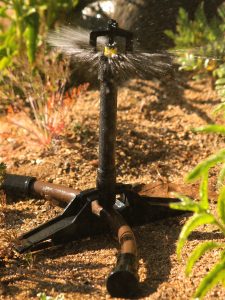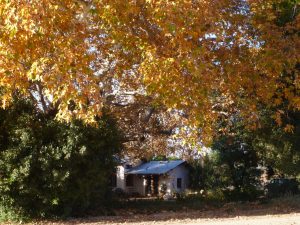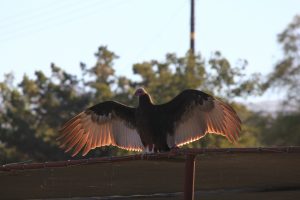November 2018 is starting out much like the same month last year, so the newsletter from November 2017 will be useful. The first beauty of gardening is that you can expect routine, repetition, and some predictability. The second beauty of gardening is that you’ll always be surprised, patterns get broken, and you’ll find that nature is not some sort of computer program. This is why gardens placed on “autopilot,” (time clocks, timed visits, timely tasks performed with mindless untimely repetition) long for a true connection with an honest person, a gardener. And this is why gardeners who spend time out in real gardens, truly love theirs so much. Reciprocity.
History and Review
Any day now. Rain. Been saying it since mid October. But according to the best forecasts, none in sight. The third beauty of gardening: hope.
Watering
Water originating from the hose or sprinkler is never as good as rain, but always better than no water at all. As your ground starts drying out on the surface (dig a little test hole about three to four inches deep), you should make “rain” showers appear. Water three days in a row, applying half inch or more of water (approx 40 minutes with most sprinkler systems). You will apply on half inch with each irrigation for a total equivalent of an inch and a half to two inches of rainfall. See our Watering Native Plants for more details.
Related to Watering
When you plant new plants this season, the perfect time by the way, be sure to water the nursery root ball in between the waterings you give the garden soil all around. Until the plant sends roots into the surrounding soil, the root ball must never go bone dry.
Pruning
Last month October 2018 we discussed pruning in great detail. Basically this season, feel free to do all the clean-up, thinning and heading back you want, always with the goal of leaving the garden more attractive that when you started. Do not take your examples from what we see all too often in many commercial landscape around town which get routinely mutilated in the name of pruning. Those plants and landscapes are not made better as a result.
We however, can be careful and artistic, using our horticultural knowledge and our keen eye to shape plants and make the whole planting immediately better, while preparing it for the next season, and keeping it healthier than it would have been if left unpruned. If you lack confidence in pruning (understandable for most beginners) no problem… just take off a few branches, do some light pruning or shearing, stand back, look at it, leave it alone a few days, go back to prune some more if necessary, until you are finished. You can always take more off, but you can never put branches back on.
Weeding
You may have some tiny seeding weeds emerging at this time. Easy to control with a hoe or shovel, or even by piling a little fresh mulch on top to deprive them of sunlight. If you sowed wildflower seeds last month, your little seedlings might be the good guys. Be careful.
Mulching/Top dress
Feel like trying something different? Customize your top dress look. Use different textures and mulch materials in drifts or natural patterns based on water flow, wind movement, shadows, or terrain. You will create a subtle mosaic on the ground under your plants. You can do this with just two or three different mulch materials (no artificial colors, dyes or paints, please), blending them as well as leaving sharp distinct lines between them in places. This is especially effective with mineral top dress, i.e.; pebbles, decomposed granite, small rocks. Try this and observe how beautifully it will accent your natural garden. You can also do just a section of the garden. No matter what, leave some bare dirt for the benefit of ground nesting native bees.
Feeding
The fall months, October and November are great times to give your natural garden a little boost with a light application of organic fertilizer. This is another topic we discussed last month, October 2018.
Troubleshooting – Varmints, Pests and Diseases
With fall, comes the arrival of winter birds, many of which are seed eaters. Oh well, what to say. If you sowed wildflower seeds last month in anticipation of winter rains, and now you see dark eyed juncos under your plants scratching around in your soil… they should at least be thanking you. Plant diseases are less active in winter. Most plant insect pests are generally also less active as we get into cooler weather. Argentine ants move scale, mealybug, and aphids to their advantage and protect them as those bad guys do damage to your plants. Use water sprays, oils, insecticidal soaps, and other organics to control. If your neighbors (certainly not you!) water a lot, you may get some brown snails. Go out at night with a flashlight, hunt them down and destroy them. With the warm October days, spider mite could show up on plants where air circulation is poor. If the infestation is severe, you’ll need a miticide.
Did you know there is an official term for the activity of walking through a farm field, nursery bed or greenhouse in search of injurious plant pests? Cruising. You should be cruising on a regular basis. Please call or write me if you have specific questions.
Annual Wildflowers
Fall is the ideal time to sow seed. We have several mixes for you to choose from.
Adding New Plants
As in October, yes, yes, and yes. This is the best planting time for natives.
Engage
Before the soil gets too cold (and maybe soggy), now it the time to go outside and play in the dirt. Plant new plants… diversity is a strong feature of the natural garden. But also, before it gets too cold and dark outside to make easy day trips, get out on the back roads to see fall color, blue skies, storms approaching (we wish!), sunrise and sunset, and feel that brisk fall air. You will report back to your garden refreshed and renewed, and rightly ready to add many creative touches to your personal “wild” space. And your garden will thank you… especially for the time you spent away finding inspiration. It’s that reciprocity thing again.
From the Garden,
Mike Evans
Questions? Help is just one call or one email away. Call (949) 728-0685 or email (with pictures if you like) our special helpline: gardenhelp@californianativeplants.com